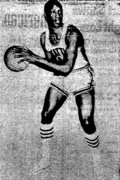Plummer Lott
Plummer E. Lott (born December 11, 1945) is a retired American professional basketball player and a New York Supreme Court justice.
 | |
| Personal information | |
|---|---|
| Born | December 11, 1945 |
| Nationality | American |
| Listed height | 6 ft 5 in (1.96 m) |
| Listed weight | 210 lb (95 kg) |
| Career information | |
| High school | Jim Hill (Jackson, Mississippi) |
| College | Seattle (1964–1967) |
| NBA draft | 1967 / Round: 5 / Pick: 54th overall |
| Selected by the Seattle SuperSonics | |
| Playing career | 1967–1969 |
| Position | Small forward |
| Number | 43 |
| Career history | |
| 1967–1969 | Seattle SuperSonics |
| Stats at Basketball-Reference.com | |
Born in Mississippi,[1] Lott was a 6'5" (1.96 m) and 210-pound (95 kg) small forward whose brief NBA career lasted with the Seattle SuperSonics from 1967 to 1969. The former Seattle University star was selected by the expansion SuperSonics in the fifth round of the 1967 NBA draft.[2]
Judicial career
Following his NBA career, Lott attended the University of Washington School of Law, graduating in 1974. After several years working as an attorney in New York City, Lott was appointed in 1991 as a judge of the New York City Criminal Court. In 1995, he was elected to the New York State Supreme Court. From 1996 to early 2009, Lott served in the Criminal Branch of the Supreme Court in Brooklyn, presiding primarily over felony cases. One of the best-known cases over which he presided involved David Hampton, a con man who posed as film legend Sidney Poitier's son — a case that inspired the play Six Degrees of Separation, and a 1994 film adaptation of the same name.[1]
In March 2009, New York Governor David Paterson appointed Lott as a Justice of the Appellate Division of the New York Supreme Court, Second Department, based in Brooklyn.[1][3][4]
Notes
- Judge in cop-slay case got court skills in NBA
- Andrieson, David (October 13, 2007), "Sonics ushered Seattle into the big time 40 years ago Saturday", The Seattle Post-Intelligencer
- Hon. Plummer E. Lott - a Brooklyn, New York (NY) Lawyer
- "Governor Paterson Announces Appellate Division Appointments" (press release, March 5, 2009).